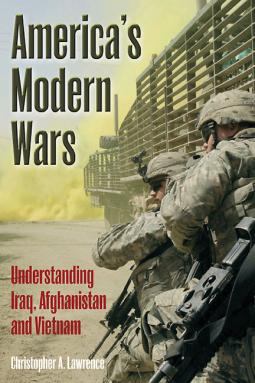
AMERICA'S MODERN WARS
Understanding Iraq, Afghanistan and Vietnam
by Christopher A. Lawrence
This title was previously available on NetGalley and is now archived.
Send NetGalley books directly to your Kindle or Kindle app
1
To read on a Kindle or Kindle app, please add kindle@netgalley.com as an approved email address to receive files in your Amazon account. Click here for step-by-step instructions.
2
Also find your Kindle email address within your Amazon account, and enter it here.
Pub Date Mar 19 2015 | Archive Date Mar 22 2016
Casemate Publishing | Casemate Publishing
Description
While the past half-century has seen no diminution in the valor and fighting skill of the U.S. military and its allies, the fact remains that our wars have become more protracted, with decisive results more elusive. With only two exceptions—Panama and the Gulf War under the first President Bush—our campaigns have taken on the character of endless slogs without positive results. This fascinating book takes a ground-up look at the problem in order to assess how our strategic objectives have recently become divorced from our true capability, or imperatives.
The book presents a unique examination of the nature of insurgencies and the three major guerrilla wars the United States has fought in Iraq, Afghanistan and Vietnam. It is both a theoretical work and one that applies the hard experience of the last five decades to address the issues of today. As such, it also provides a timely and meaningful discussion of America’s current geopolitical position.
It starts with the previously close-held casualty estimate for Iraq that The Dupuy Institute compiled in 2004 for the U.S. Department of Defense. Going from the practical to the theoretical, it then discusses a construct for understanding insurgencies and the contexts in which they can be fought. It applies these principles to Iraq, Afghanistan and Vietnam, assessing where the projection of U.S. power can enhance our position and where it merely weakens it.
It presents an extensive analysis of insurgencies based upon a unique database of 83 post-WWII cases. The book explores what is important to combat and what is not important to resist in insurgencies. As such, it builds a body of knowledge based upon a half-century’s worth of real-world data, with analysis, not opinion. In these pages, Christopher A. Lawrence, the President of The Dupuy Institute, provides an invaluable guide to how the U.S. can best project its vital power, while avoiding the missteps of the recent past.
A Note From the Publisher
EBOOK ALSO AVAILABLE
EBOOK ALSO AVAILABLE
EBOOK ALSO AVAILABLE
Advance Praise
No Advance Praise Available
No Advance Praise Available
Marketing Plan
• Trade, library and direct-audience review mailing to local, regional and national
publications
• Catalog and website advertising
• Direct-mail and internet promotion
• Simultaneous launches in the US and UK
• Sales presentations to all major chain stores, select local bookstores, national catalog
booksellers and book clubs
Available Editions
| EDITION | Hardcover |
| ISBN | 9781612002781 |
| PRICE | $32.95 (USD) |


















